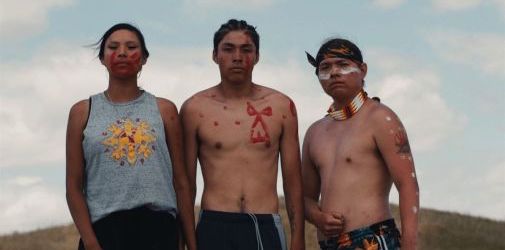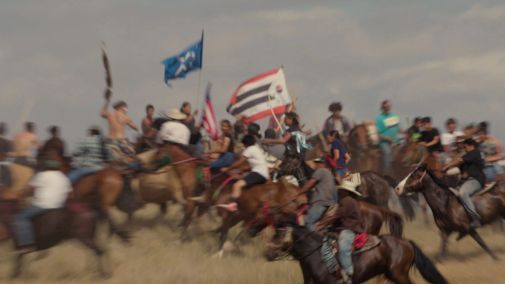Doc Corner: 'Lakota Nation Vs. United States'
 Sunday, July 16, 2023 at 6:00PM
Sunday, July 16, 2023 at 6:00PM 
If you ask me (and if you’re here, I would hope you hold my opinion in some sort of esteem), the best work of documentary so far this decade has been Raoul Peck’s four-part Exterminate All The Brutes from 2021. An epic feat of production, it brought a cinematic lens to a HBO doc-series that unflinchingly charted a history of white possession and genocide. I am hardly surprised it won a Peabody Award, but couldn’t make traction with mainstream awards bodies. Its content was tough, not made any easier as a viewing experience by the blunt-force storytelling of Peck that, maybe, people didn't expect from a multi-part doc series.
I bring this up to introduce Lakota Nation Vs. United States for a few reasons. For starters, they share an interest (if you can call it that) in the atrocities committed against Indigenous populations. It’s also very well made; beautifully shot and carefully edited with keen precision. A history book slicing a papercut into the viewer’s fingertip.
And yet, it’s certainly an easier sit than Peck’s rather all-consuming Brutes. Lakota Nation is a movie full of pain and sadness, yet just as full of hope and desire as it is with vibrating, seething anger. Directed by Laura Tomaselli and Jesse Short Bull (Mni Wanca Wicapi of the Oglala Sioux Tribe), and heavily featuring the writing of Layli Long Soldier, the film is deeply imbued with the spirit, the history, the experiences, the joys and the lives of the First Nations people that is tells the story of—in particular those of the Očéti Šakówiŋ/Lakota/Dakota/Nakota Nation and their connection to the He Sapa, or the Black Hills, that it directly speaks to.
Lakota Nation Vs United States charts the Očéti Šakówiŋ’s history with colonization and the many, many instances of American intervention, often illegal based on the settler government’s own laws. There are the reservations, and treaty. There is the discovery of gold and the (absurd) Mount Rushmore. Then there are more contemporary issues, such as the Dakota Access Pipeline (previously documented in End of the Line; not as strong of a movie, but a good one nonetheless) and the many protests that the Lakota Nation have spearheaded over the years. Protests on lands that have been legally designated as their own. As one protester asks, how can you be arrested for trespass on your own land?
It is, of course, a timely film. Unfortunately. It likely always will be. It really never does fail to strike me by how similar the stories of Indigenous peoples are, those of dispossession and so-called savagery by people whose traditions are rooted in community, dance, song and whose culture has survived out of sheer determination. Short Bull and Tomaselli capture this balance so well, charting a damning history that runs in parallel with a far less common story of nature. It’s a movie that all but lets you feel the dirt under your fingernails and the earth under your feet. Without even being there, it’s impossible to not feel the connection and therefore understand why this story is so vitally important. This is only accentuated by Long Soldier’s poetry that narrates portions of the narrative, calming and yet bubbling from fire beneath her.

But what impressed me most of all is the craft. This is a meticulously made film. Like Exterminate All The Brutes, it could probably be four-hours long and still never capture everything. That it feels complete at a succinct two hours is an achievement. Tomaselli’s own editing is refined and razor-sharp. They find a way to make it artistic and cinematic, highlighting images and landscapes that allow us feel the story of the Očéti Šakówiŋ even more deeply. But alongside those beautiful vistas are images of protest, an emphasis on bodies and paint, a very pointed spotlight of First Nations people within that landscape. Clips from films jump out as well, such as one from Steven Spielberg’s Lincoln, used to underline how a mass hanging of the Indigenous population happened at the same time as the President was signing the Emancipation Proclamation.
Lakota Nation Vs United States ends somewhat with hope. The generational image of the wild west full of savage Indians has more or less fallen away, replaced by a more modern battle between greed and idealism. The activism that many of the Očéti Šakówiŋ have embraced as we charge into an uncertain future is heartwarming and potent. The majesty and the urgency with which Lakota Nation Vs United States captures this in conversation with the horrors their people have seen over 400 years is what makes for such an incredibly powerful movie.
Release: Playing in NYC this week with LA and other cities from next Friday.
Award chances: I'd like to think so, but it may actually be a bit too precise for them (if that makes sense?). The exceptional merit in documentary category of the Emmys is likely a good spot for a major prize beyond the more highfalutin awards it could be in contention for.
 Doc Corner,
Doc Corner,  First Nations,
First Nations,  Review,
Review,  documentaries
documentaries 


Reader Comments (2)
This is a well-invested documentary, creating characters in very realistic battles. This is a great movie. free games
Hey there, I only lately came upon the a href="https://proxyline.net/en/"https://proxyline.net/en/="https://proxyline.net/en/">https://proxyline.net/en/ website where you can purchase proxies. You guys will love it! My mouth is even wide in shock at the costs, which are so low. The connection was quick, and the proxy operates flawlessly on a regular basis, which is the most significant factor. For work and games, I heartily endorse it!
https://proxyline.net/en/